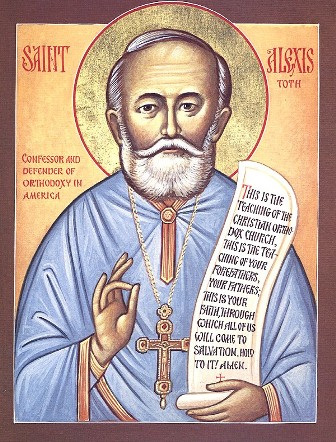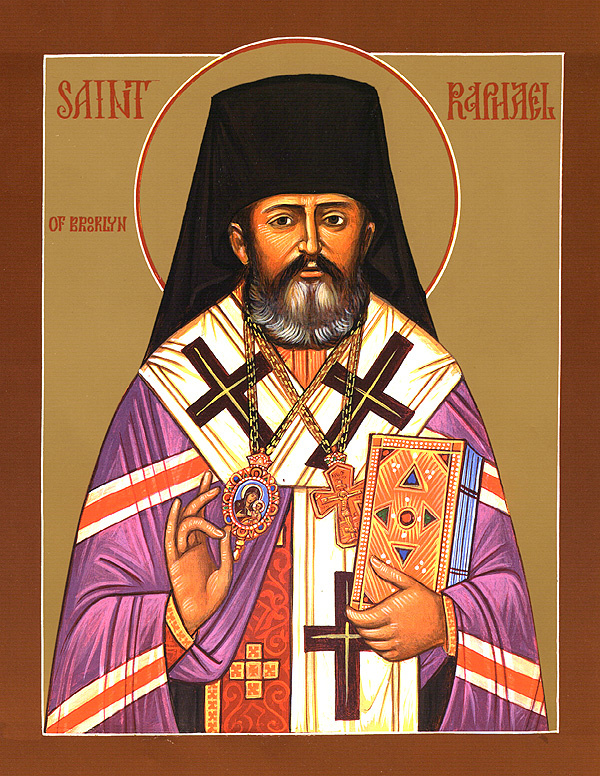The Spread of Orthodoxy in the Lower 48 States in America
The latter part of the 19th century saw the arrival and growth of the Orthodox Church in America’s “Lower 48.” Thousands of immigrants, especially in the years after 1880, came to the New World from the traditional Orthodox homelands of the Old World, seeking economic opportunity. Pan-Orthodox communities developed in Galveston, Texas (perhaps as early as 1862); New Orleans (1865); San Francisco (1867); Pittsburgh (1891); and various other places. The parish in New Orleans was given some of its churchly vessels by the Russian tsar Alexander II (r. 1855–1881).
In 1870 the first bishop of the newly formed Diocese of Alaska and the Aleutian Islands was named—Bishop John (Mitropolsky). In 1872 Bishop John moved the center of the diocese from Sitka to San Francisco, to much more readily reach out to the general American public with the story and presence of Holy Orthodoxy. Fluent in English, he was also a well-trained theologian, and until he returned to Russia in 1876, he wrote much in the local press about Orthodoxy. He also wrote a substantial study of the religious environment of the contemporary American society of his day, entitled From the History of Religious Sects in America.
Also in 1870, Nicholas Bjerring (1831–1900), a Danish Roman Catholic married layman teaching in Baltimore, Maryland, converted to Orthodoxy, was ordained a priest in Saint Petersburg, Russia, and was sent to open a kind of embassy chapel in New York City. Father Bjerring translated many liturgical works into English from German, and made great efforts, including publishing for a few years a magazine about Orthodoxy, to make the people of New York (especially Episcopalians) familiar with the faith and worship of the Orthodox Church. Unfortunately, funding for the chapel was withdrawn in 1883 by a decision of the Holy Synod of the Church of Russia. Father Bjerring had to close it, and very sadly, he left the Orthodox Church shortly thereafter. The next Orthodox church to be established in New York City was Holy Trinity Greek Orthodox Church, founded in 1891.
Conversion of the Uniates

In 1878, Saint Alexis Toth (1853–1909) was ordained as a priest of the Byzantine Rite of the Roman Catholic Church, in Slovakia. After serving for some time as Director of the Prešov Seminary, where he also taught Church History and Canon Law, he was sent in 1889 to Minneapolis, Minnesota, as a missionary priest to serve the Uniate immigrants there. However, when he reported to the local Latin-rite Roman Catholic Bishop John Ireland, upon his arrival in the city, he was rudely rejected. Two years later, he did what he said was “something which I had carried in my heart for a long time, for which my soul longed: that is, to become Orthodox.” In 1891 Bishop Vladimir (Sokolovsky; r. 1888–1891), head of the Russian mission-diocese, personally received Saint Alexis and his 361 parishioners into the Orthodox Church.
Soon thereafter, Saint Alexis was invited to serve the Uniate parish in Wilkes-Barre, Pennsylvania. After receiving the approximately 500 parishioners’ unanimous decision to become Orthodox, he began his 16 years of ministry there, until his death in 1909. In these years, enduring strong opposition from both Eastern- and Latin-rite Roman Catholics, he guided some 29,000 Uniates in 17 parishes, mostly in Pennsylvania, New York, and Connecticut, into Orthodoxy.
In 1994 the mitred Archpriest Alexis was glorified as a saint, with the title “Confessor and Defender of Orthodoxy in America,” in services held at Saint Tikhon’s Monastery in South Canaan, Pennsylvania.
The Serbs
Attracted by the California Gold Rush, Serbian immigrants began arriving in California in 1850. Some of them became involved in the Russian Orthodox parish in San Francisco established in the 1860s. This was where a Serbian-American child named Sebastian Dabovich (1863–1940) was baptized. In 1892 he became the first native-born American to be ordained as an Orthodox priest. Two years later he built Saint Sava Orthodox Church, the first Serbian Orthodox church in America, in the gold-mining town of Jackson, California. In May 2015, Sebastian was canonized by the Serbian Church and became the first American-born saint of the Orthodox Church.
The 1890s also saw the beginnings of the Holy Resurrection Serbian Orthodox Cathedral in Chicago; this would become the “Mother Church” for the Serbian immigrants in America. Also, the first Orthodox church to be established in Cleveland, Ohio, a city that would come to have many Orthodox churches, was Saint Theodosius Cathedral, founded in 1896 by the Serbian Orthodox.
The Syrians

In 1895 the community of Syrian Orthodox immigrants in New York City invited Father Raphael Hawaweeny (1860–1915), a Syrian by birth who had joined the Church of Russia and was then teaching at the missionary seminary/academy in Kazan, Russia, to come and be their priest. He accepted this offer after making it clear to these Syrians that for him to come, they would have to accept the authority of the Russian Administration in America, since he was a Russian clergyman. Thus began 20 years of fruitful ministry to the Syrian Orthodox scattered all across the United States and Mexico, including founding 30 parishes, until his death in 1915. In 1904 he was consecrated as the Bishop of Brooklyn in the first Orthodox episcopal consecration in the New World. He was glorified as a saint in 2000 by the Orthodox Church in America (OCA) and the Antiochian Archdiocese in America, at services also held at Saint Tikhon’s Monastery.
The Greeks
As with the Syrians, Greeks began emigrating to America in large numbers after about 1890. Before then, in the 1860s, earlier Greek immigrants, along with some Russian, Serbian, and Syrian immigrants, had been active in establishing the Holy Trinity parish in New Orleans. Before the turn of the century Greek immigrants had established two churches in New York City, two in Chicago, and one in Lowell, Massachusetts.
These parishes were established without reference to the Russian Administration. Priests were sent to these parishes, upon the request of the immigrants, by either the Church of Greece or the Ecumenical Patriarchate, depending on which part of the Old Country the immigrants originally came from.
